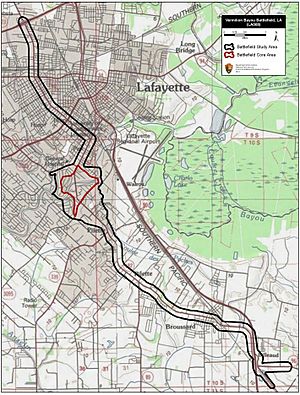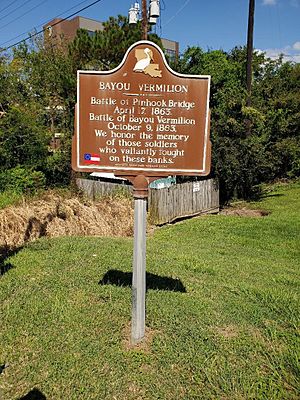Battle of Vermillion Bayou facts for kids
Quick facts for kids Battle of Vermillion Bayou |
|||||||
|---|---|---|---|---|---|---|---|
| Part of the American Civil War | |||||||
|
|||||||
| Belligerents | |||||||
| Commanders and leaders | |||||||
| Nathaniel P. Banks | Richard Taylor | ||||||
| Units involved | |||||||
|
XIX Corps CONNECTICUT-- 13th, 24th and 25th Infantry. LOUISIANA-- 1st Cavalry (Co. "F"). MAINE-- 22d and 26th Infantry. MASSACHUSETTS-- 2d Battery Light Arty.; 52d Infantry. NEW YORK-- 6th, 91st, 131st and 156th Infantry. UNITED STATES--Battery "L" 1st Arty., Battery "C" 2d Arty.</ref> |
Army of Western Louisiana | ||||||
| Casualties and losses | |||||||
| unknown, 91st NY Infantry "2 enlisted men wounded" | unknown | ||||||
The Battle of Vermillion Bayou, also known as the Battle of Pinhook Bridge, was a fight during the American Civil War. It happened on April 17, 1863. This battle was the third in a series of clashes between two important generals. On one side was Union Major General Nathaniel P. Banks. On the other side was Confederate Major General Richard Taylor. This battle took place after the Battle of Fort Bisland and the Battle of Irish Bend. Later, on October 9, 1863, a small fight between cavalry units also happened at the same spot.
Contents
Why the Battle Happened
Union Goals in Louisiana
After the Union general, Nathaniel P. Banks, had outsmarted Confederate General Richard Taylor's army, Banks kept moving. His main goal was to reach Alexandria, Louisiana. The Confederates, led by Taylor, wanted to slow Banks down. They tried to stop him as much as they could. One of these attempts to slow him down happened right outside of Vermillion Bayou.
The Battle Unfolds
Crossing the Bayou
General Taylor's smaller Confederate army was pulling back. They crossed a bridge over Vermillion Bayou. To delay Banks's Union army, Taylor's soldiers set the bridge on fire. Then, they stopped to rest. Banks was chasing Taylor. He split his army into two groups. One group went towards the burning bridge. The other group went around the side of the area.
Artillery Fire Begins
As soon as the first Union group came close to the bridge, Confederate artillery started firing. Artillery means large guns that shoot shells a long distance. The Confederate shells landed near the Union soldiers. After a while, Union artillery units arrived. Then, both sides started shooting their cannons at each other. This is called a counter-battery exchange.
Confederate Withdrawal
During the night, General Taylor knew his army was much smaller than Banks's. Because of this, he decided to pull his forces back again. He moved his army away from the battle area.
What Happened Next
Slowing Down the Union Advance
Even though General Taylor didn't defeat Banks in a major battle, he kept slowing him down. This constant slowing down prevented Banks from quickly reaching Alexandria, Louisiana. Banks's biggest goal was to capture Port Hudson, Louisiana. Taylor's actions helped delay the Union's plans.



